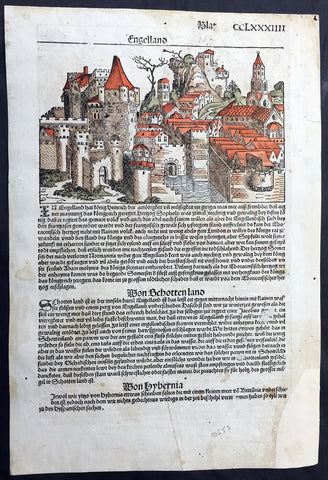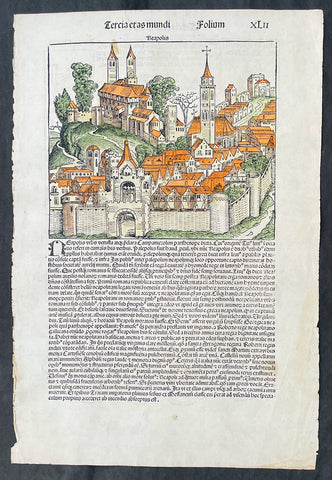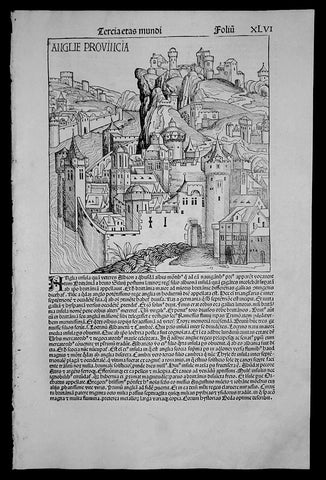
Hartmann Schedel (1440 - 1514)
Profile :
In the story of printing Nuremberg plays a major part and soon became one of the most important and influential publishing centres. Although not founded until soon after the year 1000, the city's position at the meeting point of North-South and East-West trade routes in Central Europe, and its designation in the middle of the thirteenth century as an Imperial Free City, led to rapid growth in wealth and status.
By the fifteenth century it had become one of the great cultural centres of Europe, its scholars and craftsmen exercising powerful influence throughout the Continent, not only on the development of cartography but on scientific thought in general. Many famous scholars worked or lived there including Regiomontanus (Johann Muller), the astronomer; Johann Sch6ner, astronomer and globe maker; Hartmann Schedel, cosmographer and entrepreneur; Anton Koberger, master printer; Martin Behaim, cosmographer and globe maker; and Ehrhard Etzlaub, an instrument maker who produced a road map of Central Europe, the earliest printed map of its type. And, most important of all, Albrecht Durer who was born there in 1471.
Hartmann Schedel (3)
1493 Hartmann Schedel Antique Incunable Folio Leaf of Views of England & Spain
- Title : Engelland; Von Hyspania
- Date : 1493
- Size: 16 1/2in x 11in (420mm x 280mm)
- Ref #: 50653
- Condition: (B) Good Condition
Description:
This beautifully hand coloured original antique decorative incunable* folio leaf with views a representation of England & Spain on both sides by Hartmann Schedel was published the famous Liber chronicarum or Nuremberg Chronicle, German edition 1493, the year that Columbus returned to Europe after discovering America. Page number CCLXXXIIII. One of only two views from Liber chronicarum related to the British Isles.
The woodblock cutter was Michael Wolgemut, the well-known teacher of Albrecht Dürer, and his stepson Wilhelm Pleydenwurff. Wohlgemut was Albrecht Dürer's tutor between 1486-90. Since the young Dürer was active in Wohlgemut's printer shop during the time the woodblock for the Nuremberg Chronicle have produced, he may also have collaborated, since some of the cuts bear a remarkably close resemblance to his Apocalypse illustrations.
*An incunable, or sometimes incunabulum (plural incunables or incunabula, respectively), is a book, pamphlet, or broadside (such as the Almanach cracoviense ad annum 1474) that was printed—not handwritten—before the year 1501 in Europe. "Incunable" is the anglicised singular form of "incunabula", Latin for "swaddling clothes" or "cradle",which can refer to "the earliest stages or first traces in the development of anything." A former term for "incunable" is "fifteener", referring to the 15th century.
Background: The Nuremberg Chronicle is an illustrated biblical paraphrase and world history that follows the story of human history related in the Bible; it includes the histories of a number of important Western cities. Written in Latin by Hartmann Schedel, with a version in German, translation by Georg Alt, it appeared in 1493. It is one of the best-documented early printed books—an incunabulum—and one of the first to successfully integrate illustrations and text.
Latin scholars refer to it as Liber Chronicarum (Book of Chronicles) as this phrase appears in the index introduction of the Latin edition. English-speakers have long referred to it as the Nuremberg Chronicle after the city in which it was published. German-speakers refer to it as Die Schedelsche Weltchronik (Schedel's World History) in honour of its author.
Two Nuremberg merchants, Sebald Schreyer (1446–1503) and his son-in-law, Sebastian Kammermeister (1446–1520), commissioned the Latin version of the chronicle. They also commissioned George Alt (1450–1510), a scribe at the Nuremberg treasury, to translate the work into German. Both Latin and German editions were printed by Anton Koberger, in Nuremberg. The contracts were recorded by scribes, bound into volumes, and deposited in the Nuremberg City Archives. The first contract, from December, 1491, established the relationship between the illustrators and the patrons. Wolgemut and Pleydenwurff, the painters, were to provide the layout of the chronicle, to oversee the production of the woodcuts, and to guard the designs against piracy. The patrons agreed to advance 1000 gulden for paper, printing costs, and the distribution and sale of the book. A second contract, between the patrons and the printer, was executed in March, 1492. It stipulated conditions for acquiring the paper and managing the printing. The blocks and the archetype were to be returned to the patrons once the printing was completed.
The author of the text, Hartmann Schedel, was a medical doctor, humanist and book collector. He earned a doctorate in medicine in Padua in 1466, then settled in Nuremberg to practice medicine and collect books. According to an inventory done in 1498, Schedel's personal library contained 370 manuscripts and 670 printed books. The author used passages from the classical and medieval works in this collection to compose the text of Chronicle. He borrowed most frequently from another humanist chronicle, Supplementum Chronicarum, by Jacob Philip Foresti of Bergamo. It has been estimated that about 90% of the text is pieced together from works on humanities, science, philosophy, and theology, while about 10% of the chronicle is Schedel's original composition.
Nuremberg was one of the largest cities in the Holy Roman Empire in the 1490s, with a population of between 45,000 and 50,000. Thirty-five patrician families comprised the City Council. The Council controlled all aspects of printing and craft activities, including the size of each profession and the quality, quantity and type of goods produced. Although dominated by a conservative aristocracy, Nuremberg was a center of northern humanism. Anton Koberger, printer of the Nuremberg Chronicle, printed the first humanist book in Nuremberg in 1472. Sebald Shreyer, one of the patrons of the chronicle, commissioned paintings from classical mythology for the grand salon of his house. Hartmann Schedel, author of the chronicle, was an avid collector of both Italian Renaissance and German humanist works. Hieronymus Münzer, who assisted Schedel in writing the chronicle's chapter on geography, was among this group, as were Albrecht Dürer and Johann and Willibald Pirckheimer.
The Chronicle was first published in Latin on 12 July 1493 in the city of Nuremberg. This was quickly followed by a German translation on 23 December 1493. An estimated 1400 to 1500 Latin and 700 to 1000 German copies were published. A document from 1509 records that 539 Latin versions and 60 German versions had not been sold. Approximately 400 Latin and 300 German copies survived into the twenty-first century. The larger illustrations were also sold separately as prints, often hand-coloured in watercolour. Many copies of the book are also coloured, with varying degrees of skill; there were specialist shops for this. The colouring on some examples has been added much later, and some copies have been broken up for sale as decorative prints.
The publisher and printer was Anton Koberger, the godfather of Albrecht Dürer, who in the year of Dürer's birth in 1471 ceased goldsmithing to become a printer and publisher. He quickly became the most successful publisher in Germany, eventually owning 24 printing presses and having many offices in Germany and abroad, from Lyon to Buda. (Ref Tooley M&B)
General Description:
Paper thickness and quality: - Heavy and stable
Paper color: - White
Age of map color: - Early
Colors used: - Red, green, blue, brown
General color appearance: - Authentic
Paper size: - 16 1/2in x 11in (420mm x 280mm)
Margins: - Min 1/2in (12mm)
Imperfections:
Margins: - Soiling, restoration of left margin, not affecting the imag
Plate area: - Several small worm holes, soiling
Verso: - Soiling
1493 Hartmann Schedel Antique Print View of Naples Italy & The Lineage of Christ
- Title : Neapolis
- Ref #: 17032
- Size: 17 1/2in x 12in (450mm x 300mm)
- Date : 1493
- Condition: (A+) Fine Condition
Description:
This magnificent hand coloured original wood block engraved antique view of Naples, Italy - which is believed to be one of the earliest published views of Naples - and a pictorial representation of the The Lineage of Christ on the verso, was published in the 1493 edition of Liber Chronicarum or Nuremberg Chronicle by Hartmann Schedel.
General Definitions:
Paper thickness and quality: - Heavy and stable
Paper color : - off white
Age of map color: - Early
Colors used: - Yellow, green, blue, pink
General color appearance: - Authentic
Paper size: - 17 1/2in x 12in (450mm x 300mm)
Plate size: - 9in x 7 1/2in (230mm x 190mm)
Margins: - Min 1/2in (12mm)
Imperfections:
Margins: - None
Plate area: - None
Verso: - None
Background:
The Nuremberg Chronicles were published only 40 years after first moveable type publication which revolutionised the modern world.
On the verso is a depiction of part of the family tree of the Kings of Israel: included are Kings Solomon, David and the Queen of Saba (Sheba).
The woodblock engravers were Michael Wolgemut, the well-known teacher of Albrecht Dürer, and his stepson Wilhelm Pleydenwurff. Wohlgemut was Albrecht Dürer's tutor between 1486-90 and recent scholarship has shown, Albrecht Dürer may also have collaborated, since some of the cuts bear a remarkably close resemblance to the Apocalypse illustrations.
The printing was carried out under the supervision of the great scholar-printer Anton Koberger, whose printing were famous throughout Europe.
The following is a translation of the Latin Text below the Wood-Cut.
Please note all items auctioned are genuine, we do not sell reproductions. A Certificate of Authenticity (COA) can be issued on request.
1493 Schedel Antique Pictorial View of England - London - Anglie Provincia
- Title : Anglie Provincia
- Date : 1493
- Condition: (A+) Fine Condition
- Ref: 35012
- Size: 23 1/2in x 19 1/2in (600mm x 495mm)
Description:
This magnificent fine wood block engraved original antique view of Anglia - England - which is believed to be an early representation of London - the earliest known published view of an English Town or City - was published in one of the earliest publications the 1493 edition of Liber Chronicarum or Nuremberg Chronicle by Hartmann Schedel. The Nuremberg Chronicles were published only 40 years after first moveable type publication which revolutionised the modern world.
On the verso is a depiction of part of the family tree of the Kings of Israel: included are Kings Solomon, David and the Queen of Saba (Sheba).
The woodblock engravers were Michael Wolgemut, the well-known teacher of Albrecht Dürer, and his stepson Wilhelm Pleydenwurff. Wohlgemut was Albrecht Dürer's tutor between 1486-90 and recent scholarship has shown, Albrecht Dürer may also have collaborated, since some of the cuts bear a remarkably close resemblance to the Apocalypse illustrations.
The printing was carried out under the supervision of the great scholar-printer Anton Koberger, whose printing were famous throughout Europe.
The following is a translation of the Latin Text below the Wood-Cut.
Anglie Provincia
The island of England was originally called Albion after certain white mountains which were seen by those steering towards it; but was then named Britain perpetuating the name of a fierce son (Brutus) of Silvius, the last king of the Latins, who overcame the giants inhabiting the island. It was called 'Greater' (Great) Britain to distinguish it from the lesser Britain (Brittany) of France which adjoins it. Its present-day name of England is taken from a certain 'Anglus' who was a powerful king. England forms a triangle between North and West and is separated from the continent at all points, beginning near Germany in the North and extending alongside France and Spain towards the West. Solinus regarded the French shore as the limit of this world and the island of Britain almost as belonging to another. And Virgil thought of it as separated from the rest of the globe. But Brutus having decided to settle in England, immediately founded on the banks of the River Thames a city so well fortified that it recalled in all its forces the memory of ancient Troy. This Brutus is said to have had three sons; Locrinus, Albanetus and Camber and they divided the island amonst themselves. To Locrinus, the first horn, fell all of the centre of the kingdom, which later became known as Lochria after him, and his city of London is still greatly celebrated for its merchants and traders. And many say that the Kings and Princes of England and the Parliament of the people meet to this day with the merchants there. To the second son Albanetus fell another part of the island and this was called 'Albania', but nowadays Scocia (Scotland). This Scotland occupies the higher part of the island, which lies towards the North winds and is separated from England by some smallish rivers and a certain mountain range. The third son inherited Cambria, now called Thule, the districts to the North and West which were the last to be explored by the Romans and where, during the summer solstice, the sun passes only from the star of Cancer and there is thus no night; while during the winter there is no day. The greater part of the Island is fertile. It is surrounded by many other islands of some dimensions, the largest of them Hibemia (Ireland) which is divided from Britain by a narrow channel, and some smaller ones called the Orchades (Orkneys). The blessed Pope Gregory, second of this name, sent to Britain the monks Augustine of Miletus and John with other men of outstanding character and they first converted the English. Since then many of their kings have shone forth for their miracles. The dimensions of Britain are given by Pythies and Ysidore as 38,075 [square] miles, and in it are many fine rivers, besides large and varied supplies of metals. Its history is to be found best described in Bede. (Ref: Shirley; M&B; Tooley)
General Description:
Paper thickness and quality: - Heavy and stable
Paper color: - White
Age of map color: -
Colors used: -
General color appearance: -
Paper size: - 18in x 12in (460mm x 305mm)
Margins: - Min 1/2in (12mm)
Imperfections:
Margins: - None
Plate area: - None
Verso: - None



